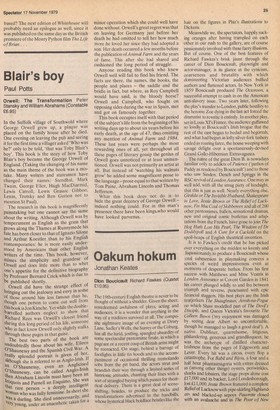Mrs moral vigilante
Nicolas Walter
Whitehouse Michael Tracey and David Morrison (Macmillan £7.95, 0.95) Mary Whitehouse and the National Viewers' and Listeners' Association are the best-known individual and organisation in the current phase of the moral vigilantist movement, and after 15 years they obviously deserve more serious treatment than sectarian polemic on either side or superficial reportage in between. Some social scientists have attempted such treatment, but the work by Michael Tracey and David Morrison raises more questions than it answers. They have produced two books — The National Viewers' and Listeners' Association, which hasn't been published and should be interesting, and Whitehouse, which has and isn't. They say that it began as 'a short academic paper' but turned into 'a full-length book', and that they are concerned not with biography but with 'the gestation of moral protest'. The trouble is that there is no significant material in this book which hasn't yet appeared in previous books or should soon appear in the forthcoming book, and which couldn't appear as an article. As so often, what is meant to be a contribution to the sociology of communication tells us more about the communication of sociology.
In this context, it is hardly necessary to say that Tracey—Morrison can't write properly. They don't know the meaning of words like 'precocious' and 'protagonist', and they don't flinch from a sentence like this: 'In a modern world of materialist theories of history, psychological theories of behaviour, relativist theories of physical space, the vision of an Althighty, the belief in some guiding hand of destiny, has dissolved beneath a shower of reason, empiricism, humanism.' After a banal introductory chapter on the cultural climate of the late 1950s and early 1960s, followed by a couple of biographical chapters, there are chapters on Mrs Whitehouse's attitude to and activities about sex, children, broadcasting in general and television drama and comedy in particular, the control and /or censorship of the media, and a concluding chapter on her concept of 'a new theocracy'. All this fills 200 pages, in which the only valuable material has been drawn from Mrs Whitehouse's private papers and her correspondence and conversation with Tracey-Morrison but hasn't been properly considered in the various relevant dimensions.
The religious dimension, the most obvious, is lacking; Tracey—Morrison say something about traditional 'Christianity in general and Moral Re-Armament in particular, but nothing about the special place of Evangelical Pro,testantism and the wider problem of pluralism inside as well as outside the Church.
The historical dimension is lacking: Tracey-Morrison take at face value Mrs Whitehouse's view that the present 'permissiveness' is unique and that her reaction to it is remarkable, and they seem quite ignorant of the double history for nearly three centuries of the movement for free-do-iniii itligioti and seX and of the countermovement of moral vigilantism (See Edward J. Bristow's recent book, Vice and Vigilance) The political dimension is lacking; Tracey—Morrison refer to Mrs Whitehouse's absurd attempts to link humanism with communism and the equally absurd attempts to link Whitehouse with Fascism, but they seem quite unaware of the real political links on either side — with traditional conservatism and authoritarianism and with traditional liberalism and libertarianism. (See their naive agreement that Mrs Whitehouse is a populist rather than an elitist, not realising that she identifies the silent majority with the noisy minority who agree with her; or their naive question about what is subversive in Alex Comfort's ideas about sex, not realising that he is a lifelong anarchist pacifist.) The psychological dimension is lacking; Tracey—Morrison say that they 'are not interested here in psychological explanations of human behaviour and motivations', which is probably just as well, but such considerations are obviously relevant on both sides. The sociological dimension is lacking; it will presumably appear in the forthcoming book. The intellectual dimension, above all, is lacking. Tracey—Morrison are surely wrong in preferring uncritical exposition to critical examination of Mrs Whitehouse's ideas; why does sbe oppose abortion and contraception, explicit sex education and all scx before or outside marriage, biological evolution and antimilitarist propaganda, and what kind of censorship does she reallY want? They are wrong about the distinction between ethical ideas of 'traditional Christianity' and 'liberal humanism', which is not that the former derive from collective and the latter from individual considerations) They are wrong about their conclusion, since Mrs Whitehouse's desire for a Christian theocracy isn't news to anyone who has taken the trouble to read or listen to her, and such a system wouldn't be new but would be a return to one which prevailed in Europe for more than a thousand years before the modern period. In fact the need for this book is lack in The only reality interesting part of t whole book is the prologue, which contains fascinating primary material on Mrs White house's prosecution of Gay News for biasphemous libel, quoted from her correspoti: dence with lawyers and clergymen. 1311] even this could appear as an article — Our indeed did so, in the August issue of Forrit and again raises more questions than answers. For example, if Whitehouse Is, right in attributing to divine providence he" success in raising money to fight the caLs: and the fact that she won it, what is ow CaY explanation of the equal success of News in raising money to fight the case .a,lelur the fact that it has led directly to a far 5 circulation of the item on which it v"'
based? The next edition of Whitehouse will probably need an epilogue as well, since it was published on the same day as the British premiere of the Monty Python film The Life of Brian . . .







































 Previous page
Previous page